Five Factors to Understand the Cuban Peso Devaluation
By Pavel Vidal
Professor at the Universidad Javeriana Cali
and former analyst at the Central Bank of Cuba
For now, the perceived errors in the reforms seem to be within the anticipated margin, given the scope of the devaluation and the unique characteristics of relative price corrections in Cuba.
The devaluation of the official exchange rate of the Cuban peso as of January 1, 2021, is the most important aspect of the recent monetary reforms in Cuba. This devaluation allows for progress toward exchange rate unification, facilitates the removal of the convertible peso (CUC) from circulation, and generates a change in relative prices to promote financial transparency and redirect economic incentives in favor of more efficient decision-making for households, enterprises, and the government. These effects are reinforced by increases in wages, reduced subsidies, and new structural reforms that are beginning to be implemented.
It will be difficult to attain an increase in average real wages in pesos throughout the state enterprise sector, given the shift from devaluation to inflation. However, increases in real wages can be anticipated in state-owned export enterprises that benefit from the devaluation, as they distribute profits. There may also be increases in real income for people working on projects funded by foreign investment, as well as in private enterprises that manage to succeed within the new parameters for self-employment, agriculture, and small- and medium-sized enterprises.
The wage increases have already begun producing incentives for formal work, which implies an increase in the labor participation rate, thus contributing to potential economic growth in the long term. Greater formalization of the labor market would also increase tax collections and social security contributions, favoring fiscal accounts. The restructuring or gradual closure of state-owned enterprises with negative balances post-devaluation, and the redirection of human and financial capital toward more competitive projects, would boost the economy's overall productivity. There are also incentives for foreign investment to operate with lower labor costs in dollars, and in better conditions to measure projects’ returns and risks, and integrate with the domestic market.
These are some of the main anticipated benefits after the 2021 Cuban peso devaluation. Some will become evident in the short term; others will take longer and require a more favorable macroeconomic environment in order to materialize. There are also collateral imbalances and risks that must be addressed to retain control over the monetary adjustment, such as accelerated inflation and the excessive expansion of the fiscal deficit and banking credit.
However, there are particular characteristics of the exchange system in Cuba and more specific issues to take into account to better understand the implications of the devaluation. We must also make a comparison with the decade of the 1990s, when significant exchange rate fluctuations also occurred.
Table 1. Cuban Peso Devaluations: 1990s vs. 2021
- 1989
- Official exchange rate (CUP:USD)
- 1.0
- Parallel exchange rate (CUP:USD)
- 5.0
- Average exchange rate * (CUP:USD)
- 1.2
- 1993
- Official exchange rate (CUP:USD)
- 1.0
- Parallel exchange rate (CUP:USD)
- 100
- Average exchange rate * (CUP:USD)
- 6.9
- 1994
- Official exchange rate (CUP:USD)
- 1.0
- Parallel exchange rate (CUP:USD)
- 40.0
- Average exchange rate * (CUP:USD)
- 3.3
- 1995
- Official exchange rate (CUP:USD)
- 1.0
- Parallel exchange rate (CUP:USD)
- 31.7
- Average exchange rate * (CUP:USD)
- 2.8
- 2000
- Official exchange rate (CUP:USD)
- 1.0
- Parallel exchange rate (CUP:USD)
- 20.8
- Average exchange rate * (CUP:USD)
- 2.4
- 2010
- Official exchange rate (CUP:USD)
- 1.0
- Parallel exchange rate (CUP:USD)
- 24.0
- Average exchange rate * (CUP:USD)
- 2.4
- 2015
- Official exchange rate (CUP:USD)
- 1.0
- Parallel exchange rate (CUP:USD)
- 24.0
- Average exchange rate * (CUP:USD)
- 2.4
- 2020
- Official exchange rate (CUP:USD)
- 1.0
- Parallel exchange rate (CUP:USD)
- 26.4
- Average exchange rate * (CUP:USD)
- 2.5
- 2021
- Official exchange rate (CUP:USD)
- 24.0
- Parallel exchange rate (CUP:USD)
- 50.0
- Average exchange rate * (CUP:USD)
- 25.6
- 1993/1989
- Official exchange rate (CUP:USD)
- 1
- Parallel exchange rate (CUP:USD)
- 20
- Average exchange rate * (CUP:USD)
- 5.6
- 1995/1993
- Official exchange rate (CUP:USD)
- 1
- Parallel exchange rate (CUP:USD)
- 0.3
- Average exchange rate * (CUP:USD)
- 0.4
- 2021/2020
- Official exchange rate (CUP:USD)
- 24
- Parallel exchange rate (CUP:USD)
- 1.9
- Average exchange rate * (CUP:USD)
- 10.1
* Weighted average with a weight of 94% for the official exchange rate and 6% for the parallel exchange rate. Based on Vidal, P. (2020): “Where the Cuban Economy Stands in Latin America: A New Measurement of Gross Domestic Product.” Cuban Studies, 49 (1), 97-118.
Table 1 summarizes the evolution of the Cuban peso’s two primary exchange rates in the Cuban economy. For simplicity, it does not include other exchange rates with intermediate values that have been used in certain operations within specific economic sectors.
The official exchange rate has undergone the greatest correction this year, breaking the parity with the US dollar and devaluing 24 times. Note that this official 1CUP:1USD exchange rate had not been adjusted since the fall of the USSR. The Cuban government used other monetary arrangements to manage the ensuing crisis of the 1990s: partial dollarization, the creation of the CUC, multiple exchange rates, exchange controls, the centralized allocation of foreign currency, and duality in monetary circuits.
Until 2020, the official 1CUP:1USD exchange rate was used or implicit in most state-sector operations and with foreign investment,[i]around 94% of GDP, according to what can be estimated with data from the National Office of Statistics and Information (ONEI). The 1:1 exchange rate was used or implicit in:
- Financial balances, and the calculation of costs and wholesale prices of state-owned enterprises.
- Financial balances of state and government organizations.
- State budgetary revenue and expenses.
- Accounting for national balances such as GDP, aggregate investment, aggregate consumption, among others.
- Balances of enterprises with foreign capital or with foreign management contracts.
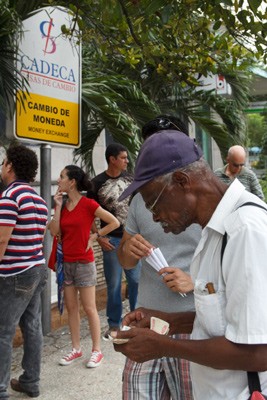
Therefore, a large part of the financial magnitudes of this 94% of the economy changes in its absolute values in 2021. But more importantly, it also changes in its relative values, which transforms the Cuban economic outlook.
The other most relevant exchange rate could be called the “parallel” rate, because it began in the informal market in the early 1990s. Later, with the creation of the state exchange bureaus (CADECA), it was institutionalized and began to be used in the private sector’s formal operations and in currency exchange by tourists and families—for example, for the conversion of personal remittances from dollars to pesos.
Note that the parallel exchange rate did present a significant devaluation during the so-called Special Period, and that it then revaluated until it stabilized at a fixed exchange rate of 24CUP:1USD. All of this involved important adjustments in those years for households, in non-state markets, and for private enterprises that were beginning to develop with the reforms of that time.
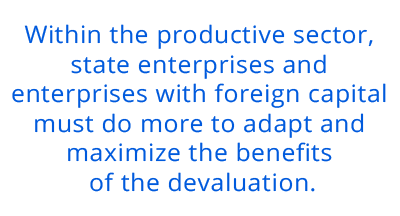
The first element to highlight is that both time periods—the Special Period of the 1990s and the current moment—experienced an asymmetric exchange rate adjustment. In the 1990s, it was concentrated in households and non-state sector markets and activities. In 2021, it is concentrated in three areas: the state enterprise sector, enterprises funded with foreign investment, and in state and government entities. Clearly, there are multiple links across all economic actors, but it is important to recognize where the epicenter of the exchange rate correction is located in each case. By doing so, we can see that within the productive sector, state enterprises and enterprises with foreign capital must do more to adapt and maximize the benefits of the devaluation.
Another data point that stands out in Table 1 is the new depreciation in 2021 in the parallel exchange rate to around 50CUP:1USD, a trend that began even before the reforms were implemented. As in the 1990s, this is being driven by black market operations. This other non-institutionalized devaluation of the parallel exchange rate cannot only be associated with the monetary reform of 2021, but also with the recession and the balance of payments crisis that the country had already been facing, influenced by the increased sanctions imposed by the Trump administration and the effects of the pandemic. Mainly due to the drop in tourism, there are fewer dollars to clear the informal exchange market.
Therefore, a second essential point regarding the 2021 exchange rate adjustment is that the monetary reform has not succeeded in producing a convergence of all exchange rates in the economy. Although the government unified institutional exchange rates at 24CUP:1USD, on the black market today the dollar has a spread of 100% in relation to the official unified exchange rate. This is a significant spread, but note that it is much lower than the 9900% that it was in 1993 (between 1CUP:1USD and 100CUP:1USD).
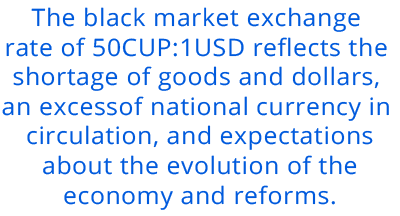
An interesting lesson from the 1990s is that this spread narrowed after reforms were applied, both structurally and to reduce the fiscal deficit. After opening up to tourism, remittances, foreign investment, and self-employment—among other reforms—and the application of the so-called “financial sanitary measures,” the parallel exchange rate appreciated 70% from 1993 to 1995.
The black market exchange rate of 50CUP:1USD reflects the shortage of goods and dollars, an excess of national currency in circulation, and expectations about the evolution of the economy and reforms. The future of the parallel exchange rate will depend on how these factors evolve.
It seems unlikely that the Central Bank will decide in the short term to reduce this exchange gap with the black market by applying a second devaluation of the exchange rate. Such a move would further accelerate inflation and foment confusion and mistrust.
The Central Bank will surely prefer to allow some time for the state enterprises and enterprises funded with foreign capital, the various markets, and the population to process and adapt to the new monetary order. This would also serve to gain a bit more clarity about the future vis-à-vis the pandemic and the speed of economic recovery, and to observe their manifestations in the parallel exchange market.
A third factor is that in terms of the economy's nominal average exchange rate, the 2021 devaluation represents almost twice the devaluation of the early 1990s. As there is more than one exchange rate, it is preferable to take an average among them (considering their relative importance) to better approximate the scope of the devaluation.
In the last column in Table 1, the average exchange rate is estimated using the share that each exchange rate has within GDP. We can see that in the 1990s the economy was subject to a nominal devaluation of 5.6 times the average exchange rate, while in 2021 the nominal devaluation is 10.1 times and it is probable that prices will increase around six times (500%)[ii].
In terms of the real exchange rate (discounting domestic inflation), in the 1990s the inflation rate exceeded the nominal devaluation and, consequently, the real exchange rate appreciated instead of depreciating. While the average nominal exchange rate depreciated 5.6 times from 1989 to 1993, prices increased 9.8 times. In 2021, in contrast, we can anticipate a real depreciation of the exchange rate; that is, inflation will not cancel out the effect of the exchange rate because the average nominal exchange rate depreciated 10.1 times and prices are likely to increase by about 5.7 times.
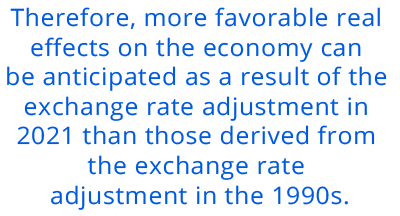
The aforementioned would result in a real currency devaluation of around 70% in 2021. Therefore, more favorable real effects on the economy can be anticipated as a result of the exchange rate adjustment in 2021 than those derived from the exchange rate adjustment in the 1990s. The fact that there is an incomplete exchange rate pass-through to inflation has enabled exporters to benefit and competitiveness to increase in a part of the tradable sector; there are also signs pointing to improved efficiency.
A fourth element to consider is that thus far the exchange rate devaluation has been insufficient to restore the convertibility of the Cuban peso. In the current deteriorating macroeconomic environment, and with very few dollars entering the balance of payments, for now neither enterprises nor individuals will be able to freely exchange Cuban pesos in dollars or other foreign currencies at banks and exchange bureaus. Only business bank accounts backed by Certificates of Liquidity (CL, now being referred to as “liquidity”) are convertible and can be used to pay for imports and international debts.
As the monetary reform begins, the national currencies and official exchange rates have been unified, but the dual economic scheme is maintained, so that enterprises and citizens with access to foreign currency maintain a disproportionate advantage over those who are not connected to these flows. The expansion of dollarization can only be stopped by restoring the convertibility of the Cuban peso. This will depend, to a large extent, on the pace of economic recovery and exports and on overcoming the balance of payments crisis.
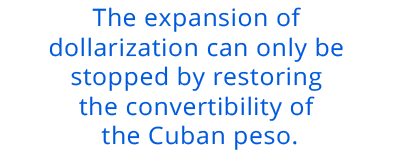
The fifth factor has to do with understanding that the current exchange rate adjustment is revealing financial losses that had been accumulating for several years, but that were not visible under the scheme of two national currencies and fixed exchange rates. The parity with the US dollar, of both the Cuban peso and the convertible peso (CUC), had been increasingly distancing from the equilibrium value of these currencies. The loss of convertibility was the clearest symptom of the imbalance.
During the last three decades, the Cuban economy was subject to multiple external shocks. However, the Central Bank kept the value of the two national currencies unchanged. Exchange control and control over capital movements, in addition to other regulations associated with a centralized economy, allowed the adjustment in the currency values to be prolonged.
The overvaluation of the Cuban peso had been growing since the Special Period. In the case of the convertible peso, overvaluation had been brewing since 2004 with de-dollarization and the abandonment of the currency board that backed it. It later worsened with the domestic financial crisis of 2008–2009, and later with the Venezuelan crisis and the tightening of sanctions under the Trump administration.
With the current monetary reforms, economic incentives are changing and creating new opportunities for the future, but at the same time some of the financial costs of past shocks (and also of poor decisions) that had been hidden under the dual currency and multiple exchange rates system are becoming visible, resulting in a transparency shock.
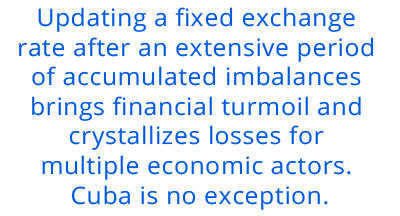
Internationally, when most economies operated under different types of fixed exchange rate regimes (fixed or sliding bands, currency boards, etc.), these adjustments happened very frequently. Examples in Latin America are Mexico (1994), Colombia (1999), and Argentina (2002). Updating a fixed exchange rate after an extensive period of accumulated imbalances brings financial turmoil and crystallizes losses for multiple economic actors. Cuba is no exception.
During the recent Eighth Congress of the Communist Party, the design and implementation of the monetary reform were critiqued. It is likely that in retrospect and given information from these first months of its implementation, some elements will be identified for rectification. For now, the evident errors seem to be within the anticipated margin based on the scope of the devaluation and the characteristics of relative price correction in Cuba.
Honestly, at this moment, it is difficult to discern which of the bad effects on the economy correspond to:
- Design errors in the monetary reform.
- Inefficiencies and problems that the devaluation brings to light (transparency shock), which those responsible for them will try to link to alleged errors of the monetary reform.
- The current economic and health crises.
- The difficulty of setting efficient prices that are taxed at equilibrium without the presence of competitive markets. This is an issue that monetary reform could not change, since it is a characteristic of the economic model.
It is important to reiterate that, in an economy with a greater number of economic actors and competitive markets, most of the adjustment in relative prices after a devaluation can be left to the interactions and counterweights of the productive system. But given the monopolistic and closed structure from which the Cuban monetary adjustment begins, the Ministry of Finance and Prices (MFP) must impose limits on price increases in the state sector, even in a suboptimal situation.
No enterprise is going to give up willingly its monopoly power to raise prices in order to stay afloat. Without competition, enterprises can use that power to pass part or all of the impact of the devaluation to their consumers by adjusting prices to increase revenues and pay the highest possible wages - all without ever accomplishing any improvement in their productive capacity.
The MFP must set dozens of prices without complete information to model the diversity of interactions and secondary and tertiary effects among the exchange rate, costs, and profit margins. It is not as if the MFP is using artificial intelligence or complex algorithms to set equilibrium prices. As usual, prices are set based on costs plus a commercial margin, with some differentiation by sectors and discretionary corrections based on information and pressures received from the state enterprise sector, Moreover, the entities charged with some of the price decentralization also do not have full capacity or information.
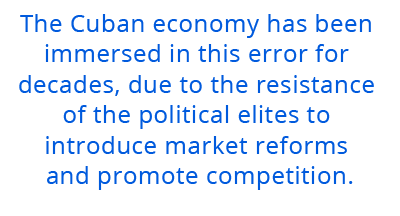
If any error can be associated with the monetary reforms, it consists of having underestimated how difficult it is to determine costs, prices, and trade margins from ministry offices, no matter how many visits are made to the provinces or meetings are organized before and after with those impacted. The Cuban economy has been immersed in this error for decades due to the resistance of the political elites to introduce market reforms and promote competition.
The configuration of price vectors that actually reflect the relative scarcity of resources and other relevant information for industries and consumers was a pending issue in the models of socialist/command economies, and is now exacerbated in 2021 in Cuba due to the magnitude of the devaluation of the Cuban peso.
[i] A group of enterprises that are either state-operated or that have foreign participation were operating in convertible pesos; in those cases, the official rate of 1CUP:1USD was implicit given the other official rate of 1CUC:1USD. Given these two official parities, an official cross rate of 1CUP:1CUC is obtained, which has been used by the Central Bank in 2021 to replace the convertible peso in some of the operations of the state enterprise sector and in enterprises with foreign participation.
[ii] See the panel with Ricardo Torres and Carmelo Mesa-Lago at the Association for the Study of the Cuban Economy (ASCE) on February 16, 2021: https://www.youtube.com/watch?v=z8KP5u_uhdc&t=161s

